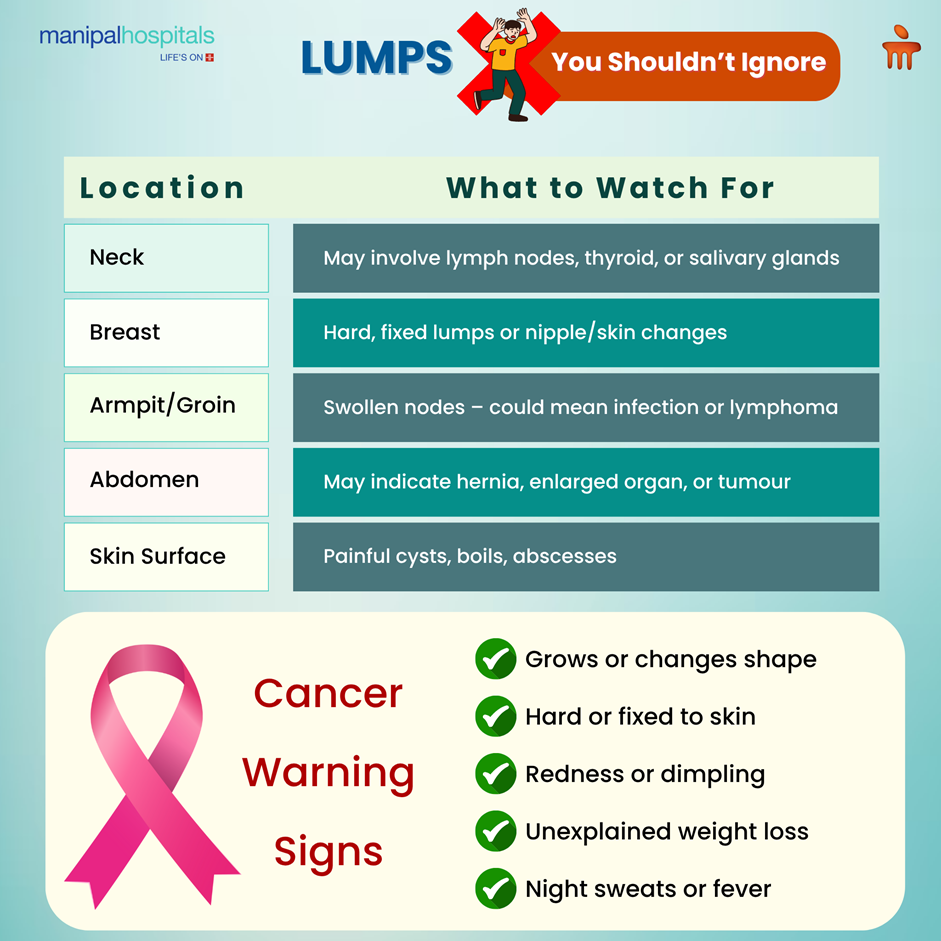
Noticing an abnormal swelling or lump in the body can bring anxiety to anyone. While most lumps are harmless or benign, some of these lumps in the body (depending on the sites) may indicate the presence of cancer, such as a lump in the breast (especially in women more than 45-50 years) is one of the earliest sign of breast cancer. Understanding the warning signs and when to visit a doctor allows you to begin appropriate care early. This blog examines the causes of body lumps, when they are cancerous, and what approach we must consider to treat these issues.
Synopsis
Common Causes of Swelling in the Body
Lumps / swelling can occur throughout the body due to various medical conditions. Body lumps can be harmless, like lipomas or fibroadenomas, or infectious, like abscesses, but in certain situations they can be a warning sign of an underlying cancer.
The following are the main reasons for a lump / swelling in your body:
-
Infections: Bacterial or viral infections cause swelling of lymph nodes and the formation of pus-filled lumps (abscesses), which can cause pain and fever symptoms.
-
Cysts: Harmless fluid sacs known as cysts may be found in the liver and kidneys, although their large size or secondary infections could make them problematic.
-
Inflammation or Injury: Swelling develops as an inflammatory response to muscle and joint injuries sustained by the body.
-
Benign Growths: Non-cancerous tumours such as lipomas (fatty lumps) often appear under the skin or fibroadenomas, which occur in the breast and grow slowly.
-
Cancerous Tumours: Some lumps may be early symptoms of cancer, especially if they are hard, immovable, and rapidly grow in size. Most of the lumps associated with cancer are painless to begin with.
When Does a Body Lump Need Attention?
The location of a lump or swelling in the body can explain its cause and whether it may be serious. Certain areas are more concerning and should be evaluated by a doctor, even without pain. Here are the key locations of a lump in the body you should not ignore:

-
Neck Lump: Swelling in the neck may involve lymph nodes, thyroid, or salivary glands and can indicate infections, thyroid issues, or cancer.
-
Breast Lump: Any lump in the breast should be checked, as it can be indicative of breast cancer, especially if it's hard or fixed, associated with changes in the nipple or skin and rapidly growing in size.
-
Groin or Armpit Lump: Swollen lymph nodes in these areas may be due to infections or, in some cases, lymphoma or other cancers.
-
Skin Surface Lumps: Lumps under the skin, such as boils, cysts, or abscesses, can be painful or infected and may need drainage or antibiotics.
-
Abdominal Lump: A lump in the stomach area could signal a hernia, an enlarged organ, or a tumour and should be examined by a doctor.
Cancer Symptoms to Watch Out For
While many lumps are non-cancerous, knowing the red flags that may suggest something more serious is vital. These warning signs can help you decide when to consult a doctor. Watch for these potential cancer symptoms:
-
Changes in Size or Shape: A lump that gets bigger in a short amount of time or changes its shape over time can be one of the cancer symptoms.
-
Pain or Tenderness: Most lumps associated with cancer are painless, but they can become painful, especially if they grow to large sizes or press on nearby nerves or tissues.
-
Skin Changes Over the Lump: Look for redness, dimpling, or darkening of the skin, which can indicate inflammation or malignancy.
-
Unexplained Weight Loss: If you're losing weight without trying and a new lump appears, it could indicate a more serious underlying issue.
-
Fever or Night Sweats: Persistent fever or sweating at night, along with a lump, may be symptoms of lymphoma or other cancers.
Read our blog for more: How To Know If You Have Breast Cancer
Diagnosis and Tests for Body Lumps
If you find a lump, your doctor will first ask about your medical history and examine the lump to assess size, texture, and location. From there, further tests may be ordered to confirm the diagnosis. Here’s how doctors evaluate and diagnose a lump in the body:
-
Physical Examination: The doctor checks the lump for size, tenderness, mobility, and consistency to determine if it's likely benign or suspicious.
-
Blood Tests: These help to identify infections, inflammation, or tumours that can give more insight into the lump’s cause.
-
Ultrasound: A quick and painless scan that shows whether the lump is solid or fluid-filled and helps guide further steps.
-
Biopsy: In this test, a small sample of the lump is taken by a needle and examined under a microscope to check for cancer cells.
-
CT / MRI / PETCT Scan: These imaging tests provide detailed images of deeper lumps or tumours, assess the stage of cancer and help to plan the right treatment.
Conclusion
Finding a lump in the body can be alarming, but most are harmless and treatable. The key is knowing when to get it checked, especially if it grows in size rapidly, changes in nature, or associated with skin changes or increased weight loss. Whether caused by infection, injury, or something more serious like cancer, early diagnosis leads to better outcomes. Don’t ignore a lump; your body is trying to tell you something. If you’ve noticed any unusual lump, schedule a visit with one of the top oncologists in Jayanagar.
FAQ's
No, most lumps are not cancerous. They can be caused by cysts, infections, or fatty growths, but it’s best to have them checked by a doctor.
Cancerous lumps are often hard, immobile, and painless. They may grow rapidly over time and not go away on their own.
You should see a doctor if the neck lump persists for over two weeks, grows in size, or is accompanied by fever, weight loss, difficulty swallowing or change in voice.
Some lumps caused by infections or minor injuries may go away without treatment, but others may need medication or surgical removal.
A biopsy is the most reliable test. In this procedure, a tissue sample from the lump is examined under a microscope to look for cancer cells.





















 6 Min Read
6 Min Read

















